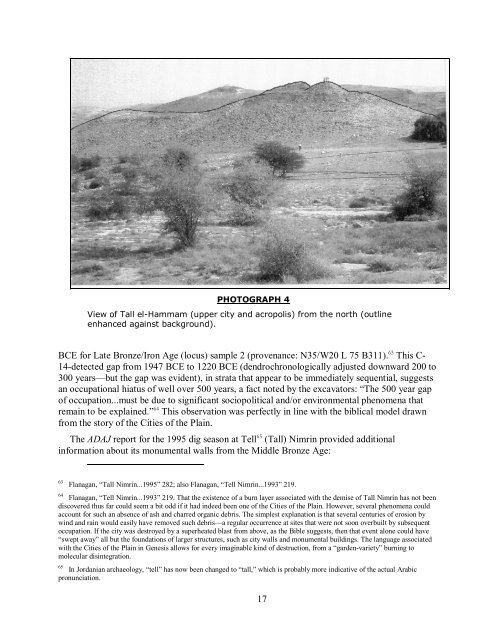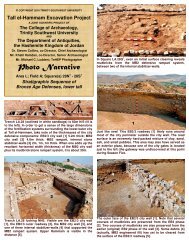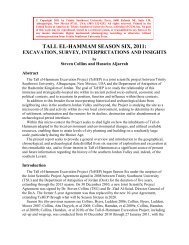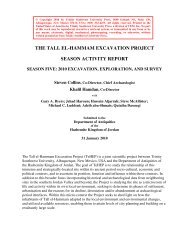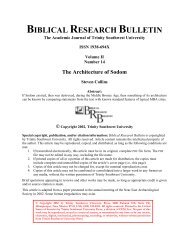Explorations on the - Tall el-Hammam Excavation Project, Jordan
Explorations on the - Tall el-Hammam Excavation Project, Jordan
Explorations on the - Tall el-Hammam Excavation Project, Jordan
You also want an ePaper? Increase the reach of your titles
YUMPU automatically turns print PDFs into web optimized ePapers that Google loves.
PHOTOGRAPH 4<br />
View of <strong>Tall</strong> <strong>el</strong>-<strong>Hammam</strong> (upper city and acropolis) from <strong>the</strong> north (outline<br />
enhanced against background).<br />
BCE for Late Br<strong>on</strong>ze/Ir<strong>on</strong> Age (locus) sample 2 (provenance: N35/W20 L 75 B311). 63 This C-<br />
14-detected gap from 1947 BCE to 1220 BCE (dendrochr<strong>on</strong>ologically adjusted downward 200 to<br />
300 years—but <strong>the</strong> gap was evident), in strata that appear to be immediat<strong>el</strong>y sequential, suggests<br />
an occupati<strong>on</strong>al hiatus of w<strong>el</strong>l over 500 years, a fact noted by <strong>the</strong> excavators: “The 500 year gap<br />
of occupati<strong>on</strong>...must be due to significant sociopolitical and/or envir<strong>on</strong>mental phenomena that<br />
remain to be explained.” 64 This observati<strong>on</strong> was perfectly in line with <strong>the</strong> biblical mod<strong>el</strong> drawn<br />
from <strong>the</strong> story of <strong>the</strong> Cities of <strong>the</strong> Plain.<br />
The ADAJ report for <strong>the</strong> 1995 dig seas<strong>on</strong> at T<strong>el</strong>l 65 (<strong>Tall</strong>) Nimrin provided additi<strong>on</strong>al<br />
informati<strong>on</strong> about its m<strong>on</strong>umental walls from <strong>the</strong> Middle Br<strong>on</strong>ze Age:<br />
63 Flanagan, “<strong>Tall</strong> Nimrin...1995” 282; also Flanagan, “T<strong>el</strong>l Nimrin...1993” 219.<br />
64 Flanagan, “T<strong>el</strong>l Nimrin...1993” 219. That <strong>the</strong> existence of a burn layer associated with <strong>the</strong> demise of <strong>Tall</strong> Nimrin has not been<br />
discovered thus far could seem a bit odd if it had indeed been <strong>on</strong>e of <strong>the</strong> Cities of <strong>the</strong> Plain. However, several phenomena could<br />
account for such an absence of ash and charred organic debris. The simplest explanati<strong>on</strong> is that several centuries of erosi<strong>on</strong> by<br />
wind and rain would easily have removed such debris—a regular occurrence at sites that were not so<strong>on</strong> overbuilt by subsequent<br />
occupati<strong>on</strong>. If <strong>the</strong> city was destroyed by a superheated blast from above, as <strong>the</strong> Bible suggests, <strong>the</strong>n that event al<strong>on</strong>e could have<br />
“swept away” all but <strong>the</strong> foundati<strong>on</strong>s of larger structures, such as city walls and m<strong>on</strong>umental buildings. The language associated<br />
with <strong>the</strong> Cities of <strong>the</strong> Plain in Genesis allows for every imaginable kind of destructi<strong>on</strong>, from a “garden-variety” burning to<br />
molecular disintegrati<strong>on</strong>.<br />
65 In <strong>Jordan</strong>ian archaeology, “t<strong>el</strong>l” has now been changed to “tall,” which is probably more indicative of <strong>the</strong> actual Arabic<br />
pr<strong>on</strong>unciati<strong>on</strong>.<br />
17


